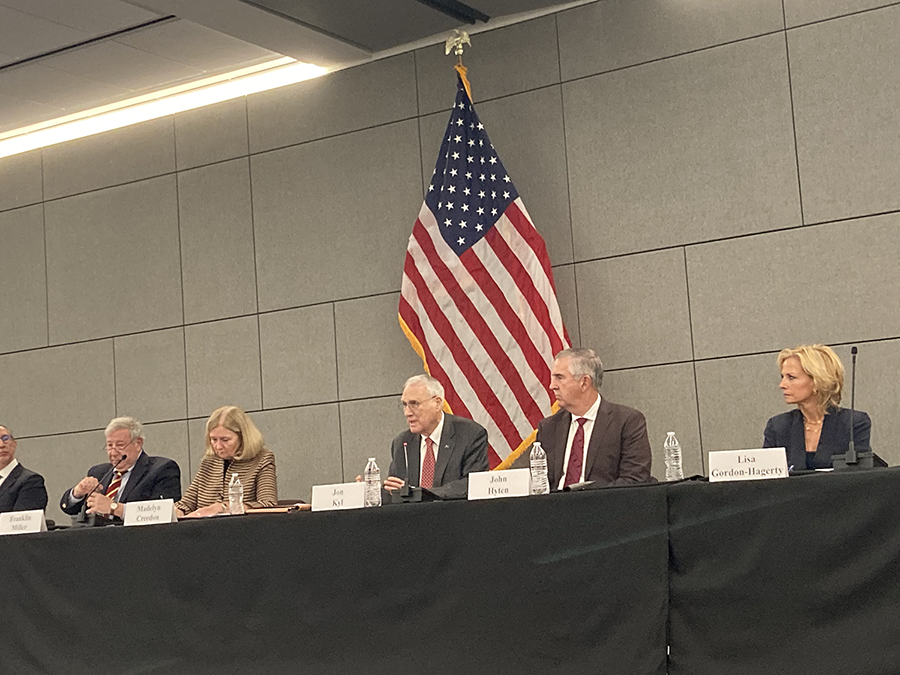"Though we have achieved progress, our work is not over. That is why I support the mission of the Arms Control Association. It is, quite simply, the most effective and important organization working in the field today."
Why We Must Reject Calls for a U.S. Nuclear Buildup
November 2023
By Daryl G. Kimball
The experience of the Cold War teaches us that an unconstrained arms race has no winners, only losers. Leaders in Beijing, Moscow, and Washington need to engage in nuclear risk reduction talks, negotiate sensible and verifiable reductions of their arsenals, and refrain from building new destabilizing types of weapons rather than proceed down the dangerous path of unconstrained nuclear competition.
 Regrettably, the final report of the Congressional Commission on the Strategic Posture of the United States, released in October, suggests that, in response to Russia’s nuclear and military behavior and the anticipated growth of China’s nuclear arsenal, the U.S. arsenal “should be supplemented” to add more capability and flexibility to counter two “near-peer” nuclear adversaries. The bipartisan commission, which consists of 12 national security insiders, also advises that the United States “must be ready to deter and defeat” both adversaries in simultaneous wars, enhance its missile defense capabilities, and significantly bolster its nuclear weapons capabilities, including with new theater-range weapons.
Regrettably, the final report of the Congressional Commission on the Strategic Posture of the United States, released in October, suggests that, in response to Russia’s nuclear and military behavior and the anticipated growth of China’s nuclear arsenal, the U.S. arsenal “should be supplemented” to add more capability and flexibility to counter two “near-peer” nuclear adversaries. The bipartisan commission, which consists of 12 national security insiders, also advises that the United States “must be ready to deter and defeat” both adversaries in simultaneous wars, enhance its missile defense capabilities, and significantly bolster its nuclear weapons capabilities, including with new theater-range weapons.
If there is a military conflict between nuclear-armed states, however, deterrence will have failed, and there will be no “winners.” Once nuclear weapons are used in a war between nuclear-armed adversaries, there is no guarantee that a nuclear war could be contained.
In the current context, any decision to increase the number of deployed U.S. strategic nuclear weapons higher than the levels of the New Strategic Arms Reduction Treaty (New START) could trigger a dangerous action-reaction cycle. It would not enhance deterrence in the face of China’s growing nuclear capabilities or Russia’s existing capabilities. In response, China could deploy more nuclear weapons on an even wider array of delivery systems, and Russia would seek to match any increases in the U.S. nuclear force.
As U.S. Defense Secretary Lloyd Austin noted on Dec. 9, 2022, “Nuclear deterrence isn’t just a numbers game. In fact, that sort of thinking can spur a dangerous arms race.”
The U.S. nuclear arsenal, which includes roughly 1,800 deliverable strategic warheads, 150 substrategic warheads, and thousands of warheads in reserve, still exceeds what is necessary to hold a sufficient number of adversary targets at risk so as to deter a nuclear attack.
U.S. National Security Advisor Jake Sullivan, in an address on June 2, reiterated that “the United States does not need to increase our nuclear forces to outnumber the combined total of our competitors to effectively deter them.”
Increasing the number of nuclear weapons or adding new types of nuclear weapons to the U.S. arsenal would also be prohibitively expensive. A Congressional Budget Office report in July estimated that the existing U.S. nuclear modernization program would cost a staggering $756 billion in 2023-2032. The commission’s recommendations, if pursued, would require hundreds of billions of dollars more.
Although the commission’s report generally supports U.S. efforts to engage China and Russia in nuclear risk reduction, it seriously underplays the importance of strong U.S. leadership on arms control in preventing an unconstrained nuclear arms race. Its recommendations in this area reflect a failure of imagination, a lack of consensus, or both.
Contrary to existing U.S. policy and practice, “the [c]ommission recommends that once a strategy and its related force requirements are established, the U.S. government determine whether and how nuclear arms control limits continue to enhance U.S. security.” In reality, arms control is a critical element of such an effective national security strategy, not an afterthought. That is why the Biden administration’s 2022 Nuclear Posture Review states that “[m]utual, verifiable nuclear arms control offers the most effective, durable and responsible path to reduce the role of nuclear weapons in our strategy and prevent their use.”
According to Sullivan, the United States is ready to engage in nuclear arms control diplomacy with Russia and other nuclear-armed members of the nuclear Nonproliferation Treaty (NPT) “without preconditions.” He emphasized that “rather than waiting to resolve all of our bilateral differences, the United States is ready to engage Russia now to manage nuclear risks and develop a post-2026 arms control framework.”
New bilateral nuclear arms control limits with Russia may be difficult to achieve as long as Russia’s war on Ukraine rages. Even so, the United States could seek an executive agreement or a reciprocal unilateral arrangement verified with national technical means of intelligence that commits Russia and the United States to respect New START’s central limits on strategic arsenals until a more permanent, comprehensive nuclear arms control arrangement is concluded.
Instead of threatening to take actions that might accelerate dangerous nuclear competition, the United States must exercise prudent nuclear restraint and energetically pursue effective arms control and disarmament diplomacy with Russia, China, and other nuclear-armed states inside and outside of the NPT.
